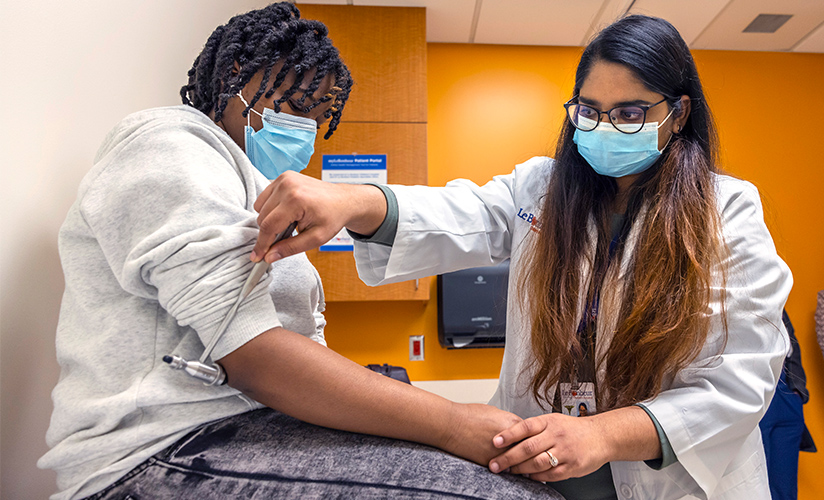Neuroscience Institute Launches Comprehensive Headache Center
While typically a minor inconvenience, headaches can turn into a chronic, debilitating condition for some children causing disruption in their lifestyle, school performance and relationships. Pediatric Neurologist Ankita Ghosh, MD, director of Le Bonheur’s Comprehensive Headache Center, aims to help these kids not just address their pain but understand the headache disorder process, too.
“The patients who come to our center seek pain relief, but we also want to address the disease process. Our goal is not just to treat patients but also to educate them so that they feel confident in managing their condition,” says Ghosh.
Which is why Ghosh, a trained pediatric headache specialist, makes it a priority to meet directly with each new patient in the Headache Center for as long as it takes to thoroughly understand their history, concerns and potential treatment options. Ghosh completed a fellowship in pediatric headache at Cincinnati Children’s Hospital and specializes in primary headache disorders. In clinic, patients have access to Ghosh, Nurse Practitioner Olivia McComb, DNP, CPNP-PC, and Psychologist Gwen Beard, PsyD, in the same visit.
Ghosh addresses acute and preventive headache treatment, lifestyle management and cognitive behavioral therapy for migraines taking a holistic approach to managing headache disorders. Studies have shown that the combination of preventive therapy along with cognitive behavioral therapy for chronic migraine provides the best outcomes, says Ghosh. She ensures that every patient and family can meet with a psychologist to address relevant concerns such as comorbid disorders (anxiety, phobias, difficulty with pill swallowing, etc.) and learn coping skills.
“Our goal is that by the end of clinic our patients feel more self-confident about their management of care,” said Ghosh. “It’s rewarding to see when your patient’s headaches improve.”
As treatment for pediatric headache expands and changes, Ghosh plans to bring Le Bonheur to the forefront of these new treatment opportunities. Ongoing research in this field is poised to open new avenues of treatment including uncovering the genetic components of headaches – specifically migraine.
For example, Ghosh is participating in several current research efforts for pediatric headache including determining dosage amounts and protocols for dihydroergotamine (DHE) in the Emergency Department and the connection between joint hypermobility and pediatric migraines. But her interest in genetics of headache could also unlock cures and provide answers for the origin of pediatric headaches.
“We are more than just a clinic, we are a headache center,” says Ghosh. “We want to give patients the opportunity to enroll in research trials that might benefit them.”

Study: Trigeminal autonomic cephalalgias can begin early in life and exhibit similar symptoms as adults
All five headache disorders comprising trigeminal autonomic cephalalgias (TAC) can begin early in life and exhibit many of the same symptoms as TACs in adult populations, according to a study published in Cephalalgia by Director of Le Bonheur’s Comprehensive Headache Center Ankita Ghosh, MD. Literature on TACs in pediatric populations has been very limited and little is known about these headaches in children.
TACs include cluster headache, paroxysmal hemicrania, short-lasting unilateral neuralgiform headache attacks with conjunctival injection and tearing (SUNCT), short-lasting unilateral neuralgiform headache attacks with cranial autonomic symptoms (SUNA) and hemicrania continua.
“In cluster headache, the most common TAC, there is typically a delay in diagnosis of several years because of atypical headache features and lack of awareness of cluster headache in younger patients,” said Ghosh. “The objectives of our review and meta-analysis were to report on the full age ranges of pediatric TACs and determine if kids and adults with TACs display similar symptoms.”
In the meta-analysis, Ghosh and colleagues identified 86 studies for systematic review. Results showed that every type of TAC can begin early in life. The youngest age of diagnosis for each TAC in this review was 1 year old for cluster headache and SUNA, 2 years old for paroxysmal hemicrania and SUNCT and 6 years old for hemicrania continua.
In this review, cluster headache was the pediatric TAC with the most available data. Cluster headaches were shown to be present in every pediatric age (1-18 years) and met the full criteria for cluster headaches established for adults in the ICHD-3 (International Classification of Headache Disorders). The most common differences between adult and pediatric symptoms were the frequency and location of attacks. Cluster headache diagnosis was also delayed or misdiagnosed as migraine in pediatric patients because pediatric patients had less cranial autonomic features and restlessness but similar rates of migraine symptoms.
The other types of TACs reviewed in this meta-analysis met most but not all ICHD-3 criteria, and very few studies examined these headache disorders in children. Further study is needed to understand the differences between adult and pediatric onset for these headache disorders.
“Our review of current literature strongly suggests that all five TACs can start very early in life,” said Ghosh. “These results have clinical implications for neurologists caring for pediatric patients with headache disorders to better diagnose and treat them appropriately.”
Clinical implications
- All five TACs can start early in life. Data is strongest for cluster headache.
- Pediatric-onset and adult-onset cluster headache have similar features. Cluster headache may be confused with migraine in children because of lower rates of cranial autonomic features and a similar rate of prototypically migrainous features.
- Pediatric cluster headache can be distinguished from migraine by attack duration less than two
hours (more consistent with cluster headache) or more than three hours (more consistent with migraine). When the attack duration is two to three hours, pediatric cluster headache can be distinguished by number of attacks per day (more than one), presence of restlessness and strictly unilateral pain.
Help us provide the best care for kids.
Le Bonheur Children's Hospital depends on the generosity of friends like you to help us serve 250,000 children each year, regardless of their family’s ability to pay. Every gift helps us improve the lives of children.
Donate Now








